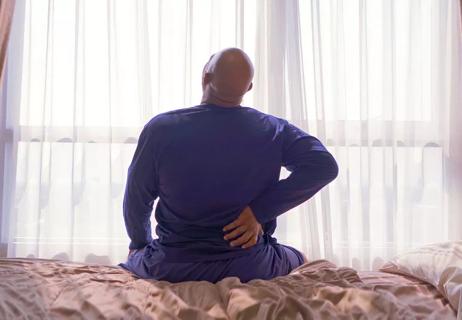Improve your shoulder’s range of motion before moving to strengthening workouts

So your shoulder hurts and it’s getting worse by the day. All of a sudden, combing your hair comes with a small bite of pain. Odds are, you’re dealing with some sort of rotator cuff tear or injury.
Advertisement
Cleveland Clinic is a non-profit academic medical center. Advertising on our site helps support our mission. We do not endorse non-Cleveland Clinic products or services. Policy
Welcome to the club. Rotator cuff issues are common, an unfortunate side effect from the wear and tear of daily life. More than 2 million Americans visit their doctor every year because of rotator cuff pain.
So what stretches and exercises can you do to keep your shoulder working without making you wince? Physical therapist Kelly Kinsey, MSPT, AT, has some ideas.
Let’s start with the basics: A partial or complete tear of a rotator cuff muscle can make it difficult to just raise or move your arm. Expect to feel a general weakness in your joint. Your range of motion may be less than ideal, too.
But that doesn’t mean workouts are a definite no-go. Two key factors determine how much you’ll be able to do after injuring your rotator cuff — the severity of your injury and your ability to tolerate pain.
“Some people can exercise with a tear and some people can’t,” says Kinsey. “That’s the truth of it. There isn’t just one answer.”
The good news? Converting that bum shoulder into a healthier wing to keep your fitness routine on track is very doable. Roughly 8 out of 10 people with partial rotator cuff tears get better using options like:
Advertisement
“Over a month or two, particularly with physical therapy, people are often able to get back to where they feel comfortable,” says Kinsey. “It’s a slow and gradual process.”
Here’s where that PT process often begins.
The first step in treating an injured rotator cuff is restoring the range of motion. “We start them with very basic exercises to rebuild flexibility within the joint,” explains Kinsey. “Movement first. Strength later.”
Here are three stretches to keep your shoulder limber for day-to-day activities.
This stretch uses both arms, allowing your good shoulder to help your bad one. You’ll need a light cane or rod. “This stretch helps you better reach overhead, like when you’re putting away dishes,” says Kinsey.
This stretch also uses both arms (aka, the buddy system) and a light cane or rod. The idea is to improve flexibility reaching behind you, making it easier to put on a coat, fasten a bra or simply scrub your back in the shower.
“This is another classic early exercise we give people that have an injured rotator cuff to get movement in the joint,” says Kinsey.
Once your range of motion improves, treatment moves toward strengthening your shoulder joint. A rotator cuff tear won’t heal on its own, but building up surrounding muscles takes some stress off the injured area.
The process needs to be slow and progressive. “There’s the potential for a small tear to become a larger tear,” notes Kinsey. “Don’t push through the pain with the idea that it’s adding strength. You may do more harm than good.”
Advertisement
So if your range of motion has returned in your shoulder, consider these strength-building moves.
You’ll need a rubber exercise band for this maneuver, which helps set a solid base for your rotator cuff.
This exercise will engage the most number of muscles in your shoulder girdle while also being safe to do.
This exercise starts with just using bodyweight. Once you can do it easily and with no pain, consider holding a 1- or 2-pound weight.
Advertisement
If you’re a fitness buff trying to work through your rotator cuff issues at the gym with free weights, you’ll quickly learn to avoid lifting anything straight over your head. (It’ll hurt … and probably a lot).
But a few lifts that put added strain on your bad shoulder might surprise you. The list includes:
If you truly can’t stay away from the gym, Kinsey offers this advice: Work your legs. “Focus on a different area for a little bit,” she says. “Just give your shoulders a break.”
Advertisement
Learn more about our editorial process.
Advertisement

Rest, physical therapy, pain relief medication and steroid injections may be able to help instead

3 tips to help you sleep easier

The short answer from an orthopaedic sports medicine surgeon

Looking down at your smartphone or computer screen can stress muscles in your neck, shoulders and back

Tendinopathy tends to get better with rest, ice, pain management and physical therapy

It could be an injury, arthritis, a bone infection or even the position of your collarbone

Don’t ignore obvious warning signs of more serious shoulder issues

Find the right sleep position to tame your joint pain

Start having sex about 72 hours before ovulation, then at least every other day during your fertile window

Attachment theory suggests that your earliest relationships shape connections throughout your life

It isn’t a recognized mental health disorder, but research shows that problematic social media use can negatively affect your mental health, self-esteem and sleep